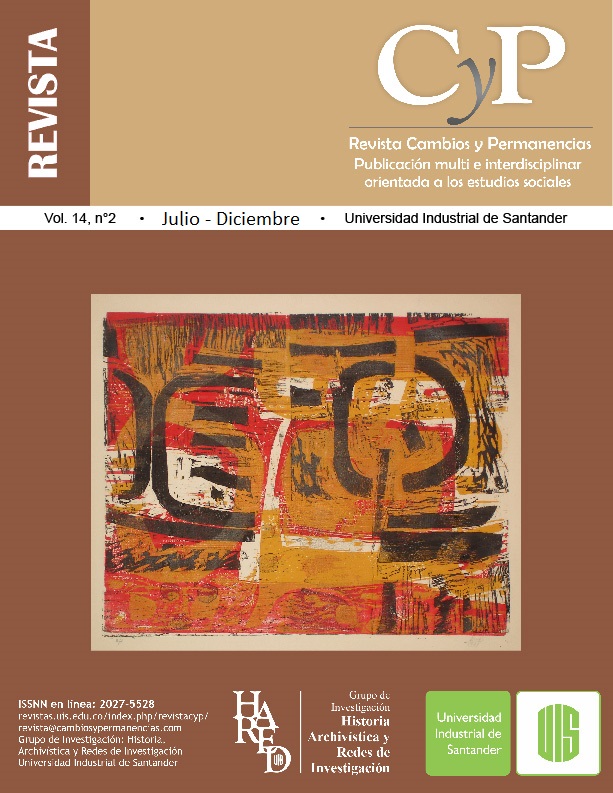ABSENCE AND PRESENCE OF THE CANYON OF THE BARRANCA COMMUNE: Pursuit of the monument, symbol of workers’ participation during popular force
Published 2023-10-30
Keywords
- Right to Memory,
- Places of Memory,
- Historical Memory,
- Barrancabermeja
How to Cite

This work is licensed under a Creative Commons Attribution 4.0 International License.
Abstract
The places of memory as developments in the field of study of collective memory have gained relevance for understanding
violent conflicts and the way in which a community elaborates or manages its past. The events of April 9th, 1948 in Barrancabermeja,
where a Revolutionary Junta created a type of popular government, accounting for a strong organization that seemed to be based
on traditions and learned from the oil strikes. Some cannons made by the workers during the revolutionary experience were kept by
the National Army and one of these, placed for decades as a monument on the fac ade of the Nueva Granada Battalion, until it was
removed and replaced. In order to maintain the memory of the monument made by the workers, a search exercise is deployed which goes before military and judicial authorities, with the aim of investigating its whereabouts and highlighting its historical and cultural value, between the struggle of an official version and another memory collective, which opens the discussion around the convergence of History with Human Rights and the defense of these places, from the perspective of the right to the Truth and to the Historical Memory, that victims and societies that have suffered damage due to experiences of political violence have.
Downloads
References
- Abattista, M., Barletta, A., & Lenci, L. (2016). La historia va al tribunal en la Palta. Una vuelta de tuerca sobre comprender y juzgar. Memoria Académica.
- Aguilera, M. (2011). El orden desarmado. La resistencia de la Asociación de Trabajadores Campesinos del Carare (ATCC). Taurus
- Alape, A. (1981, 5 de abril). Los días de abril del 48 en Barranca. El Espectador.
- Archila, M. (1986). Aquí nadie es forastero. Testimonios sobre la formación de una cultura radical: Barrancabermeja 1920-1950. Controversia. CINEP.
- Buenahora, G. (1947). Discurso pronunciado por el Dr. Gonzalo Buenahora en los salones del honorable concejo municipal de Barrancabermeja, en sesión solemne del 20 de julio de 1947, para inaugurar el cuadro de ¨ El héroe José Antonio Galán llevado al patíbulo¨ o ¨ El manto de América¨, Oleo del maestro Pedro Nel Gómez, ejecutado con destino al cabildo de la ciudad. Gaceta Municipal.
- Buenahora, G. (1972). La Comuna de Barranca. 9 de abril de 1948.
- Buenahora, G. (1982). Sangre y Petróleo. Bogotá.
- Díaz. A. (1988). El 9 de abril 1948 en Barrancabermeja DIEZ DÍAS DE PODER POPULAR. Bogotá.
- Ferretti. M. (2003). Memory Disorder Rusia and Stalinism. Russian politics and law, 41(6), 32-82.
- Ibáñez, T., y Íñiguez, L. (1996). Aspectos metodológicos de la psicología social aplicada. Barcelona.
- López, A. (2011). Anécdotas de Barrancabermeja. Corporación Memoria y Patrimonio.
- Ministerio de Cultura. (2013). Política para la protección del patrimonio cultural mueble. https://drive.google.com/file/d/1StXlg5n6WlSipciwhp-gzpiIf0juUnJK/view
- Molano, A. (2015). Fragmentos de la historia del conflicto armado (1929-2010). En Conflicto social y rebelión armada. Gentes del Común.
- Mosseri, J. (1969). Plan de Ordenamiento Urbano para Barrancabermeja. Centro de planificación y urbanismo de la Universidad de los Andes.
- Nora, P. (2008). Entre Memoria e Historia. La Problemática de los lugares. En Historia de Segundo Grado. Pierre Nora y los Lugares de la Memoria. Ediciones Trilce.
- Petro, G. (2022). Una vida, muchas vidas. Planeta.
- Piper, I. (2005). Obstinaciones de la memoria: La dictadura militar chilena en las tramas del recuerdo [tesis doctoral]. Universidad Autónoma de Barcelona.
- Vargas, A. (1989). Tres momentos de la violencia política en San Vicente de Chucurí (de los Bolcheviques del año 29 a la fundación del ELN). Análisis Político, 8.
- Velásquez, R. y Pita, R. (2022). Barrancabermeja. Una visión bibliográfica. UIS. Fundación Identidad Arte y Cultura.
- Vega, R.; Núñez, L. y Pereira, A. (2009). Petróleo y protesta obrera. La Unión Sindical Obrera. (USO) y los trabajadores petroleros en Colombia (1923-2008). Corporación . Aury Sará Marrugo.
- Vynyes, R. (2009). Memorial del Estado. España.

